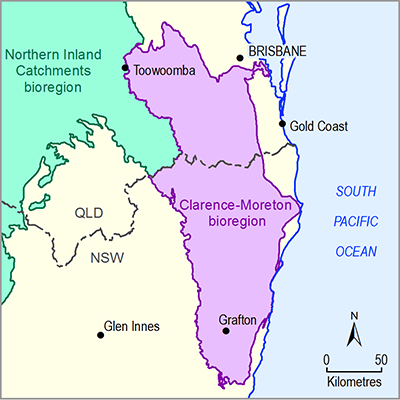2.6.2.7.2.1 Drawdown due to the additional coal resource development
Two types of groundwater-dependent assets were considered for the groundwater modelling in the Clarence‑Moreton bioregion: groundwater-dependent ecosystems (Figure 6 in companion product 1.3 for the Clarence‑Moreton bioregion (Murray et al., 2015)), and bores that were classified as economic assets (Figure 12 and Figure 13 in companion product 1.3 for the Clarence‑Moreton bioregion (Murray et al., 2015)). For both types, direct impact of CSG extraction is reported as the maximum difference in groundwater level between the baseline and the coal resource development pathway (CRDP) – referred to as additional drawdown, together with the time at which this maximum groundwater level change is realised.
The additional drawdown is simulated at 982 model nodes (Figure 24) for the uppermost layer of the groundwater model. The hydrological change in the watertable aquifer at all model nodes, or any model node, can be computed through interpolation from these nodes. The location of the model nodes was generated with a bivariate normal distribution with the mean centred on the CSG development. A subsequent manual adjustment ensured that redundant nodes (multiple nodes within a single MODFLOW grid cell) were removed and nodes were added in regions with low node density.
Figure 24 Distribution of the 982 model nodes in layer 1 for prediction interpolation
Coal resource development pathway = baseline + additional coal resource development (ACRD); PAE = preliminary assessment extent
Data: Bioregional Assessment Programme (Dataset 4)
Model nodes associated with economic assets (bores) in layer 2 occur across the additional coal resource development (ACRD) extent while model nodes in other layers are mostly outside the extent. No model nodes were identified in layer 5.
Coal resource development pathway = baseline + additional coal resource development; PAE = preliminary assessment extent
Data: Bioregional Assessment Programme (Dataset 5)
The predictions at two representative model nodes are illustrated in Figure 26 using the modelling results from a single realisation, realisation 842. The locations of these model nodes are indicated in Figure 24 and Figure 25. Among all models assessed during the sensitivity analysis, this realisation is the best-fit by comparing model outputs with historical groundwater level observations, water production forecast and estimated baseflow based on historical hydrograph. The model selection procedure was described in companion product 2.5 for the Clarence‑Moreton bioregion (Cui et al., 2016). The model-generated baseflow in September and October, averaged from 1983 to 2012, at the Casino surface water model node (CLM_008) for this realisation is 89.2 ML/day, which is consistent with the observed streamflow in these months (Figure 23).
Model node pdm_324 is in layer 1 (alluvium, Lamington Volcanics and unconfined parts of the sedimentary bedrock) situated in the central part of West Casino Gas Project (Figure 24). The CRDP groundwater model shows an additional drawdown in 2040, after which groundwater level gradually recovers towards the end of the simulation period. The additional drawdown is calculated to occur in 2042. It is noteworthy that the additional drawdown does not coincide exactly with the lowest groundwater level simulated under the CRDP.
Model node pdm_1291 is associated with economic assets (bores) in layer 3 (Bungawalbin Member) near the northern margin of the CSG development field about 10 km west of Kyogle (Figure 25). The additional drawdown is calculated to occur in 2055, which is 13 years later than model node pdm_324.
dmax = maximum difference in drawdown between the coal resource development pathway and baseline, due to additional coal resource development (ACRD)
Coal resource development pathway = baseline + additional coal resource development
Data: Bioregional Assessment Programme (Dataset 3)
2.6.2.7.2.2 Baseflow change due to the additional coal resource development
The difference in exchange flux between aquifers and surface water features due to the additional coal resource development was reported at 16 surface water model nodes located within the groundwater model domain (Figure 27). The results, which reflect a change in river baseflow, were fed back into the Australia Water Resources Assessment (AWRA) landscape model (AWRA‑L) to predict changes in total streamflow and other flow indices due to the additional coal resource development. The change due to the additional coal resource development on hydrological response variables associated with surface water is reported in companion product 2.6.1 for the Clarence‑Moreton bioregion (Gilfedder et al., 2016). The baseflow change was reported as aggregated flow rate variation over all the cells above a surface water model node. For example, the baseflow change at CLM_014 is a sum of the change at all cells that interact with rivers above CLM_014 (Figure 27).
Surface water model node CLM_001 is represented as “1”, CLM_002 is represented as “2”, etc.
Coal resource development pathway = baseline + additional coal resource development (ACRD); PAE = preliminary assessment extent
Data: Bioregional Assessment Programme (Dataset 6)

Product Finalisation date
- 2.6.2.1 Methods
- 2.6.2.2 Review of existing models
- 2.6.2.3 Model development
- 2.6.2.4 Boundary and initial conditions
- 2.6.2.5 Implementation of the coal resource development pathway
- 2.6.2.6 Parameterisation
- 2.6.2.7 Observations and predictions
- 2.6.2.8 Uncertainty analysis
- 2.6.2.9 Limitations and conclusions
- Citation
- Acknowledgements
- Contributors to the Technical Programme
- About this technical product




